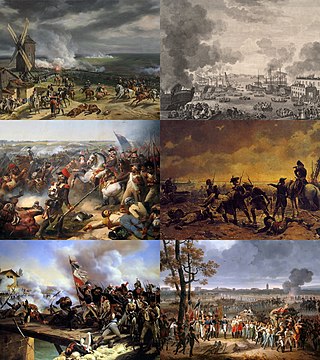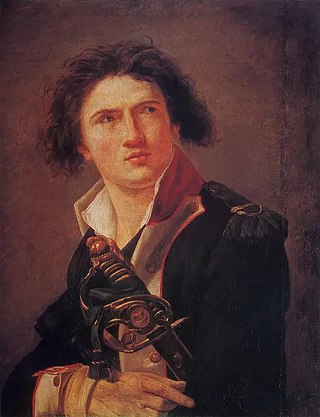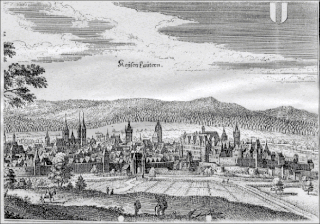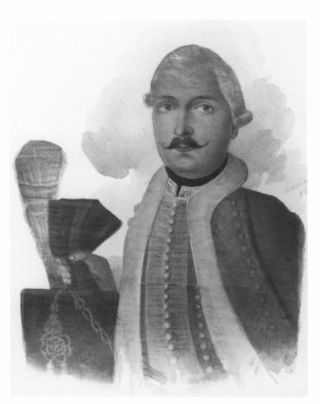
Wissembourg is a commune in the Bas-Rhin department in Grand Est in northeastern France.

The War of the First Coalition was a set of wars that several European powers fought between 1792 and 1797, initially against the constitutional Kingdom of France and then the French Republic that succeeded it. They were only loosely allied and fought without much apparent coordination or agreement; each power had its eye on a different part of France it wanted to appropriate after a French defeat, which never occurred.

Louis Lazare Hoche was a French military leader of the French Revolutionary Wars. He won a victory over Royalist forces in Brittany. His surname is one of the names inscribed under the Arc de Triomphe, on Column 3. Richard Holmes describes him as "quick-thinking, stern, and ruthless... a general of real talent whose early death was a loss to France."

Jean-Étienne Vachier Championnet, also known as Championnet, led a Republican French division in many important battles during the French Revolutionary Wars. He became commander-in-chief of the Army of Rome in 1798 and of the Army of Italy in 1799. He died in early 1800 of typhus. His name is one of the names inscribed under the Arc de Triomphe, on Column 3.

Jean-Charles Pichegru was a French general of the Revolutionary Wars. Under his command, French troops overran Belgium and the Netherlands before fighting on the Rhine front. His royalist positions led to his loss of power and imprisonment in Cayenne, French Guiana during the Coup of 18 Fructidor in 1797. After escaping into exile in London and joining the staff of Alexander Korsakov, he returned to France and planned the Pichegru Conspiracy to remove Napoleon from power, which led to his arrest and death. Despite his defection, his surname is one of the names inscribed under the Arc de Triomphe, on Column 3.

Dagobert Sigismund, Count von Wurmser was an Austrian field marshal during the French Revolutionary Wars. Although he fought in the Seven Years' War, the War of the Bavarian Succession, and mounted several successful campaigns in the Rhineland in the initial years of the French Revolutionary Wars, he is probably most remembered for his unsuccessful operations against Napoleon Bonaparte during the 1796 campaign in Italy.

The Wissembourg Gap is a corridor of open terrain, approximately six kilometres wide, between the hills of the Palatinate Forest to the west and the Bienwald forest to the east. It marks the border between the Palatinate to the north and Alsace to the south, and by extension between Germany and France. The Gap is dominated by the French town of Wissembourg, from which it takes its name. The average altitude of the land in the corridor rises from 150 metres by the Bienwald to 250 metres by the Palatinate Forest.

The Battle of Kaiserslautern saw a Coalition army under Charles William Ferdinand, Duke of Brunswick-Wolfenbüttel oppose a Republican French army led by Lazare Hoche. Three days of conflict resulted in a victory by the Prussians and their Electoral Saxon allies as they turned back repeated French attacks. The War of the First Coalition combat was fought near the city of Kaiserslautern in the modern-day state of Rhineland-Palatinate, Germany, which is located about 60 kilometres (37 mi) west of Mannheim.
The Lines of Weissenburg, or Lines of Wissembourg, were entrenched works — an earthen rampart dotted with small outworks — along the river Lauter. They were built in 1706 and lasted into the 19th century.

Johann Mészáros von Szoboszló joined the Habsburg army in 1756 and fought the Prussians, Ottoman Turks, and French during a long military career. During the French Revolutionary Wars, he fought in several campaigns. He commanded a division in the 1796-1797 Italian campaign against the army of Napoleon Bonaparte. He was Proprietor (Inhaber) of an Austrian Uhlan regiment from 1792 to 1797 and a Hussar regiment from 1797 to 1801.

Antoine Morlot was a French division commander during the French Revolutionary Wars and Napoleonic Wars. After almost eight years of service in the French Royal Army, he became an officer in a local volunteer battalion during the French Revolution. In 1792 he fought with distinction at Thionville and other actions, earning a promotion to general officer in 1793. He was notable for his participation at the Battle of Kaiserslautern where he led a brigade. After another promotion he became a general of division in the Army of the Moselle. In 1794 he led his troops at Arlon, Lambusart, Fleurus and Aldenhoven.

Johann Josef Cajetan Graf von Klenau, Freiherr von Janowitz was a field marshal in the Habsburg army. Klenau, the son of a Bohemian noble, joined the Habsburg military as a teenager and fought in the War of Bavarian Succession against Prussia, Austria's wars with the Ottoman Empire, the French Revolutionary Wars, and the Napoleonic Wars, in which he commanded a corps in several important battles.

In the First Battle of Wissembourg an Allied army commanded by Dagobert Sigmund von Wurmser attacked the French Army of the Rhine under Jean Pascal Carlenc. After an ineffectual resistance, the French army abandoned its fortified line behind the Lauter River and retreated toward Strasbourg in confusion. This engagement of the War of the First Coalition occurred on the eastern border of France about 60 kilometres (37 mi) north of Strasbourg.

Gerhard Ritter von Rosselmini or Gherardo Rosselmini or Gerhard Roselmini became a general officer in the Austrian army during the French Revolutionary Wars and fought in several actions against Napoleon Bonaparte's French army during the 1796 Italian campaign. From 1789 to 1794 he commanded an Austrian infantry regiment. He led the unit in several battles on the upper Rhine in 1793 before being captured. He was promoted to General Major in early 1794. Rosselmini died in Italy while on campaign.
The Battle of Kaiserslautern saw an army from the Kingdom of Prussia and Electoral Saxony led by Wichard Joachim Heinrich von Möllendorf fall upon a single French Republican division under Jean-Jacques Ambert from the Army of the Moselle. The Prussians tried to surround their outnumbered adversaries but most of the French evaded capture. Nevertheless, Möllendorf's troops inflicted casualties on the French in the ratio of nine-to-one and occupied Kaiserslautern. While the Prussians won this triumph on an unimportant front, the French armies soon began winning decisive victories in Belgium and the Netherlands. The battle occurred during the War of the First Coalition, part of the French Revolutionary Wars. In 1794 Kaiserslautern was part of the Electoral Palatinate but today the city is located in the state of Rhineland-Palatinate in Germany about 67 kilometres (42 mi) west of Mannheim.

Jean René Moreaux commanded the French Army of the Moselle during the French Revolutionary Wars. He joined the French Royal Army in 1776 and was badly wounded in the American Revolutionary War two years later. After leaving military service, he married and took over the family business. At the time of the French Revolution he was elected second in command of a volunteer battalion. He was rapidly promoted, emerging as a general officer in May 1793. After another promotion, he led a corps at Pirmasens and a division at Wissembourg. He was appointed commander of the Army of the Moselle in June 1794. In November he was sent with three divisions to invest the fortress of Luxembourg. He caught a fever and died during the Siege of Luxembourg. His surname is one of the names inscribed under the Arc de Triomphe.

The Battle of Froeschwiller saw Republican French armies led by Lazare Hoche and Charles Pichegru attack a Habsburg Austrian army commanded by Dagobert Sigmund von Wurmser. On the 18th, a French attack pushed back the Austrians a short distance. After more fighting, a powerful assault on the 22nd forced the entire Austrian army to withdraw to Wissembourg. The action occurred during the War of the First Coalition, part of the Wars of the French Revolution. Froeschwiller is a village in Bas-Rhin department of France, situated about 50 kilometres (31 mi) north of Strasbourg.
The Battle of Haguenau saw a Republican French army commanded by Jean-Charles Pichegru mount a persistent offensive against a Coalition army under Dagobert Sigmund von Wurmser during the War of the First Coalition. In late November, Wurmser pulled back from his defenses behind the Zorn River and assumed a new position along the Moder River at Haguenau. After continuous fighting, Wurmser finally withdrew to the Lauter River after his western flank was turned in the Battle of Froeschwiller on 22 December. Haguenau is a city in Bas-Rhin department of France, located 29 kilometres (18 mi) north of Strasbourg.

The siege of Landau saw a corps from the Kingdom of Prussia commanded by Frederick Louis, Prince of Hohenlohe-Ingelfingen lay siege to a 3,800-man French Republican garrison led by Joseph Marie Tennet de Laubadère. Since the Prussians lacked siege cannons, they tried to starve the French defenders into surrender by blockading the city. In late December, the French Army of the Moselle under Lazare Hoche and Army of the Rhine under Jean-Charles Pichegru defeated the Coalition armies opposed to them, forcing the Prussians to raise the War of the First Coalition siege.
Paul-Alexis Dubois commanded French divisions during the War of the First Coalition and was killed in action fighting against Habsburg Austria. He enlisted in a French infantry regiment in 1770 and transferred into the cavalry in 1776. Thereafter he served in several different cavalry and infantry regiments. From sous-lieutenant in 1791, he served in the Army of the Moselle and was rapidly promoted to general of brigade by August 1793. After briefly commanding an infantry division in the Army of the Rhine at Wissembourg he switched back to the Army of the Moselle to fight at Kaiserslautern before being wounded at Froeschwiller in December 1793.

















